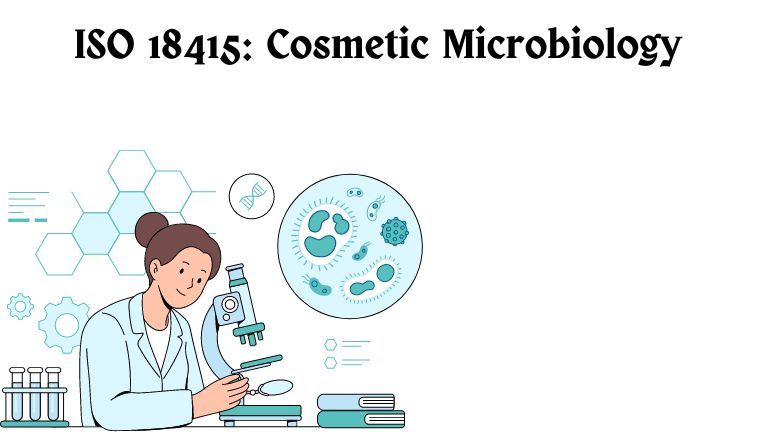ISO 18415 is a standard established by the International
Organization for Standardization (ISO) that addresses the evaluation of
antimicrobial protection in cosmetic products. As consumer awareness about
hygiene and safety continues to grow, the cosmetics industry faces increasing
pressure to ensure that its products not only meet aesthetic and functional
expectations but also adhere to strict safety standards. ISO 18415 provides an
essential framework for cosmetic manufacturers to assess the efficacy of
antimicrobial agents in their products, ensuring they are safe for consumer
use.
Overview of
ISO 18415
ISO 18415, titled "Cosmetics — Microbiology — Detection
of specified and non-specified microorganisms," is part of a broader
family of standards designed to ensure that cosmetic products are free from
harmful microorganisms. The presence of pathogens such as bacteria, fungi, or
yeasts in cosmetics can pose significant risks to consumer health, especially
when applied to sensitive areas like the face or skin. ISO 18415 is crucial
because it outlines the methods for detecting both specified (target) and
non-specified microorganisms in cosmetic products.
The standard is applicable to a wide range of cosmetic
products, including those with minimal water activity or those that contain
preservatives meant to inhibit microbial growth. Cosmetic manufacturers use
this standard to ensure that their products meet the necessary microbiological
safety requirements, ensuring product stability and consumer safety.
The Importance of Microbiological Testing in
Cosmetics
Cosmetics come into contact with the skin, hair, and in some
cases, sensitive areas such as the eyes and mouth. Consequently, the risk of
contamination with harmful microorganisms must be minimized. Microbiological
testing is essential for assessing the safety and quality of cosmetic products
throughout their production process and shelf life.
ISO
18415 offers a structured approach to assess the presence of microorganisms,
ensuring that cosmetics remain free from harmful contaminants.
Key Features of ISO 18415
ISO 18415 focuses on microbial testing and assessment of
cosmetic products. Below are some of its key features:
1. Detection of Specified Microorganisms: ISO 18415 sets
specific guidelines for the detection of microorganisms that are most commonly
associated with contamination risks in cosmetics. These include bacteria,
fungi, and yeasts. The standard includes protocols for isolating and
identifying these microbes.
2. Non-Specified Microorganisms: While it is critical to
target specific microorganisms that are known to cause health issues, ISO 18415
also acknowledges that non-specified microorganisms (those not typically
targeted in tests) can still pose contamination risks. The inclusion of
guidelines for detecting non-specified microorganisms provides a more
comprehensive approach to product safety.
3. Evaluation of Preservative Efficacy: Many cosmetic
products contain preservatives designed to prevent microbial contamination
during storage and usage. ISO 18415 evaluates the efficacy of these
preservatives in protecting products from microbial growth, ensuring the
longevity of the product and its safety for consumers.
4. Sampling and Testing Protocols: The standard includes
detailed methods for sampling cosmetic products and conducting tests in
laboratory conditions. These protocols are designed to ensure reproducibility
and accuracy in detecting microorganisms in different product types, such as
creams, lotions, shampoos, and powders.
5. Relevance to Different Product Categories: ISO 18415 is
applicable to a variety of cosmetic product categories, ranging from
water-based products that are more susceptible to microbial growth to anhydrous
(water-free) products that may have lower microbial risk but still require
testing to ensure safety.
The Role of ISO 18415 in Regulatory Compliance
In the cosmetics industry, product safety is paramount. Various
international regulations, such as the European Union's Cosmetics Regulation
(EC) No. 1223/2009 and the U.S. Food and Drug Administration's (FDA)
guidelines, place strict requirements on cosmetic manufacturers to ensure their
products are free from harmful contaminants. ISO 18415 supports manufacturers
in achieving compliance with these regulations by providing clear,
internationally recognized guidelines for microbiological testing.
In the European Union, cosmetic manufacturers must ensure
that their products undergo a comprehensive safety assessment before they can
be placed on the market. ISO 18415 plays a vital role in this process, offering
standardized methods for detecting microbial contamination, which is a critical
aspect of the safety assessment. Similarly, in the United States, the FDA
monitors cosmetic safety and sets guidelines for manufacturers to follow.
Adherence to ISO 18415 can help manufacturers meet these regulatory
requirements and avoid potential recalls or legal action due to contaminated
products.
Benefits of ISO 18415 Certification
Obtaining certification for ISO 18415 offers several benefits
to cosmetic manufacturers, ensuring product safety and enhancing brand
credibility. Here are some of the key advantages:
1. Improved Product Safety: By adhering to ISO 18415,
manufacturers can ensure that their products are free from harmful
microorganisms, reducing the risk of infections, irritations, or other adverse
effects on consumers.
2. Increased Consumer Confidence: Consumers are increasingly
conscious of product safety and hygiene, particularly in light of recent global
health concerns. ISO 18415 certification demonstrates a commitment to
maintaining high safety standards, which can boost consumer confidence in the
brand.
3. Regulatory Compliance: Compliance with ISO 18415 ensures
that products meet the microbiological safety requirements set by regulatory
bodies around the world. This minimizes the risk of product recalls, legal
issues, or bans on product sales in certain markets.
4. Enhanced Product Shelf Life: The evaluation of
preservative efficacy in ISO 18415 helps manufacturers optimize their product
formulations to enhance the shelf life of their cosmetics. This reduces the
risk of product spoilage or degradation, ensuring that products remain safe and
effective for longer periods.
5. Competitive Advantage: In a highly competitive cosmetics
market, ISO 18415 certification can serve as a unique selling point for brands,
setting them apart from competitors who may not have the same level of
microbiological safety testing.
Implementation
of ISO 18415 in the Cosmetic Industry
For cosmetic manufacturers, implementing ISO 18415 involves
integrating microbiological testing into various stages of the product
lifecycle, from formulation and production to packaging and distribution. This
requires collaboration between different departments, including research and
development, quality assurance, and regulatory compliance teams.
Laboratories responsible for conducting microbiological tests
must be equipped with the necessary tools and expertise to follow ISO 18415
protocols accurately. Regular training and updates on the latest testing
methods are essential to maintain compliance and ensure that the results are
reliable and reproducible.
Additionally, manufacturers must establish effective
communication with suppliers, particularly those providing raw materials or
preservatives. Ensuring that these components meet the necessary safety and
quality standards is critical for the overall success of ISO 18415
implementation.
Conclusion
ISO 18415 plays a critical role in the cosmetics industry,
offering a comprehensive framework for evaluating antimicrobial protection in
products. By adhering to the guidelines set out in this standard, cosmetic
manufacturers can ensure the safety and quality of their products, comply with
regulatory requirements, and build consumer trust. As the demand for safe,
high-quality cosmetics continues to grow, ISO 18415 will remain an essential
tool for manufacturers looking to meet these expectations while maintaining a
competitive edge in the market.

